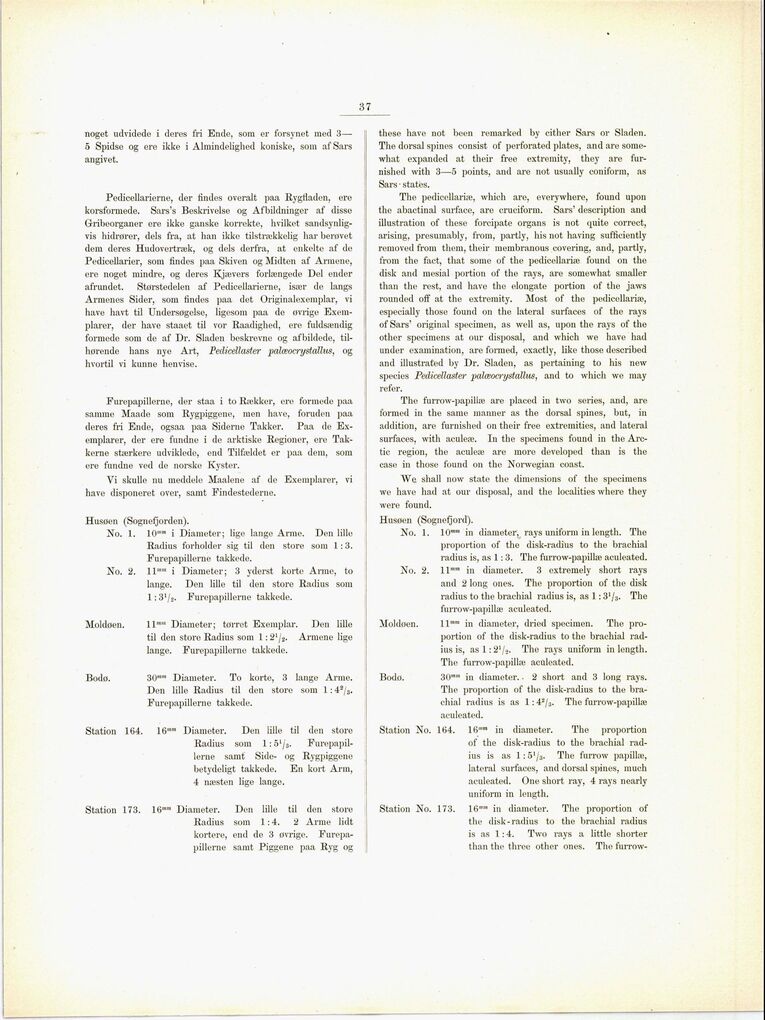
Full resolution (JPEG) - On this page / på denna sida - Sidor ...

<< prev. page << föreg. sida << >> nästa sida >> next page >>
Below is the raw OCR text
from the above scanned image.
Do you see an error? Proofread the page now!
Här nedan syns maskintolkade texten från faksimilbilden ovan.
Ser du något fel? Korrekturläs sidan nu!
This page has never been proofread. / Denna sida har aldrig korrekturlästs.
37
noget udvidede i deres fri Ende, som er forsynet med 3—
5 Spidse og ere ikke i Almindelighed koniske, som af Sars
angivet.
Pedicellarierne, der findes overalt paa Rygttaden, ere
korsformede. Sars’s Beskrivelse og Afbildninger af disse
Gribeorganer ere ikke ganske korrekte, hvilket
sandsynligvis hidrører, dels fra, at han ikke tilstrækkelig har berøvet
dem deres Hudovertræk, og dels derfra, at enkelte af de
Pedicellarier, som findes paa Skiven og Midten af Armene,
ere noget mindre, og deres Kjævers forlængede Del ender
afrundet. Størstedelen af Pedicellarierne, især de langs
Armenes Sider, som findes paa det Originalexemplar, vi
have havt til Undersøgelse, ligesom paa de øvrige
Exemplarer, der have staaet til vor Raadighed, ere fuldsændig
formede som de af Dr. Sladen beskrevne og afbildede,
tilhørende hans nye Art, Pedicéllaster palæocrystallus, og
hvortil vi kunne henvise.
Furepapillerne, der staa i to Rækker, ere formede paa
samme Maade som Rygpiggene, men have, foruden paa
deres fri Ende, ogsaa paa Siderne Takker. Paa de
Exemplarer, der ere fundne i de arktiske Regioner, ere
Takkerne stærkere udviklede, end Tilfældet er paa dem, som
ere fundne ved de norske Kyster.
Vi skulle nu meddele Maalene af de Exemplarer, vi
have disponeret over, samt Findestederne.
Husøen (Sognefjorden).
No. 1. 10mm i Diameter; lige lange Arme. Den lille
Radius forholder sig til den store som 1:3.
Furepapillerne takkede.
No. 2. llmm i Diameter; 3 yderst korte Arme, to
lange. Den lille til den store Radius som
1:31/2- Furepapillerne takkede.
Moldøen. llmm Diameter; tørret Exemplar. Den lille
til den store Radius som 1: ä’/g. Armene lige
lange. Furepapillerne takkede.
Bodø. 30mm Diameter. To korte, 3 lange Arme.
Den lille Radius til den store som 1:42/3.
Furepapillerne takkede.
Station 164. 16°"" Diameter. Den lille til den store
Radius som 1:51/8.
Furepapillerne samt Side- og Rygpiggene
betydeligt takkede. En kort Arm,
4 næsten lige lange.
Station 173. 16""" Diameter. Den lille til den store
Radius som 1:4. 2 Arme lidt
kortere, end de 3 øvrige.
Furepapillerne samt Piggene paa Ryg og
these have not been remarked by cither Sars or Sladen.
The dorsal spines consist of perforated plates, and are
somewhat expanded at their free extremity, they are
furnished with 3—5 points, and are not usually coniform, as
Sars • states.
The pedicellariæ, which are, everywhere, found upon
the abactinal surface, are cruciform. Sars’ description and
illustration of these forcipate organs is not quite correct,
arising, presumably, from, partly, his not having sufficiently
removed from them, their membranous covering, and, partly,
from the fact, that some of the pedicellariæ found on the
disk and mesial portion of the rays, are somewhat smaller
than the rest, and have the elongate portion of the jaws
rounded off at the extremity. Most of the pedicellariæ,
especially those found on the lateral surfaces of the rays
of Sars’ original specimen, as well as, upon the rays of the
other specimens at our disposal, and which we have had
under examination, are formed, exactly, like those described
and illustrated by Dr. Sladen, as pertaining to his new
species Pedicéllaster palæocrystallus, and to which we may
refer.
The furrow-papillæ are placed in two series, and, are
formed in the same manner as the dorsal spines, but, in
addition, are furnished on their free extremities, and lateral
surfaces, with aculeæ. In the specimens found in the
Arctic region, the aculeæ are more developed than is the
case in those found on the Norwegian coast.
We shall now state the dimensions of the specimens
we have had at our disposal, and the localities where they
were found.
Husøen (Sognefjord).
No. 1. 10mm in diameter, rays uniform in length. The
proportion of the disk-radius to the brachial
radius is, as 1: 3. The furrow-papillæ aculeated.
No. 2. llmm in diameter. 3 extremely short rays
and 2 long ones. The proportion of the disk
radius to the brachial radius is, as 1: The
furrow-papillæ aculeated.
Moldøen. 11""" in diameter, dried specimen. The
proportion of the disk-radius to the brachial
radius is, as 1:2’/2. The rays uniform in length.
The furrow-papillæ aculeated.
Bodø. 30""" in diameter. • 2 short and 3 long rays.
The proportion of the disk-radius to the
brachial radius is as 1:42/3. The furrow-papillæ
aculeated.
Station No. 164. 16ram in diameter. The proportion
of the disk-radius to the brachial
radius is as 1:5’/3. The furrow papillæ,
lateral surfaces, and dorsal spines, much
aculeated. One short ray, 4 rays nearly
uniform in length.
Station No. 173. 16""" in diameter. The proportion of
the disk-radius to the brachial radius
is as 1:4. Two rays a little shorter
than the three other ones. The furrow-
<< prev. page << föreg. sida << >> nästa sida >> next page >>